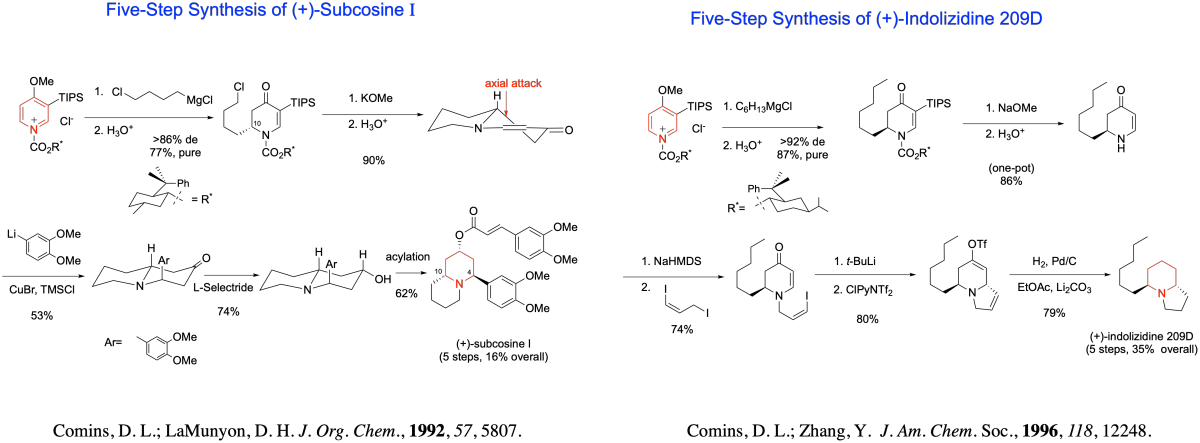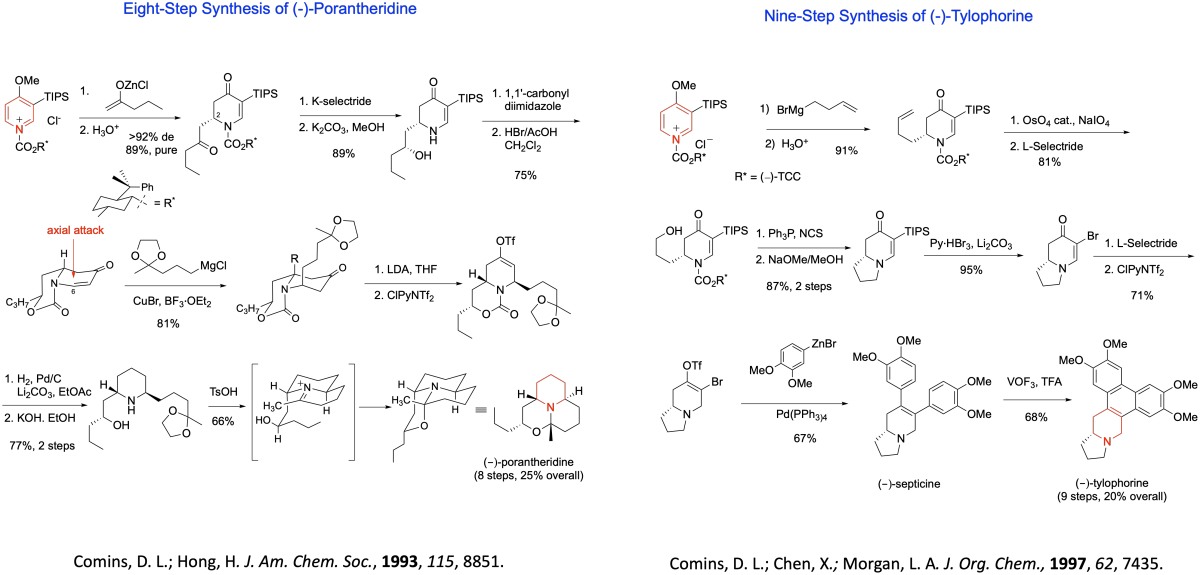Research
The principal emphasis of Professor Comins’ research program is the development of new synthetic methodologies and strategies for the asymmetric synthesis of alkaloids, natural products and biologically active compounds. Several strategies based on heterocyclic and organometallic chemistry have been developed.
The Comins group develops methodology useful for the synthesis of compounds having a broad range of biological properties, i.e. neuroleptic, antihypertensive, anti-inflammatory, antitumor, and anticonvulsant activities. Other studies include basic research on the development of synthetic methods for the synthesis of optically active compounds using novel heterocycles as chiral building blocks. The Comins group has accomplished the synthesis of over 40 alkaloids. Synthetic achievements include asymmetric syntheses of (+)-elaeokanine A, (+)-elaeokanine C, (-)-septicine, (-)-tylophorine, (-)-laudanosine, (+)-carnegine, (+)-glaucine, (-)-xylopinine, (-)-pumiliotoxin C, (-)-lasubine I, (+)-subcosine I, (-)-sedamine, (+)-camptothecin, (+)-10-hydroxycamptothecin, (-)-porantheridine, (-)-indolizidine 235B, (-)-indolizidine 205A, (+)-indolizidine 209D, (-)-indolizidine 207A, trans-decahydroquinoline alkaloid (+)-219A, piperidine alkaloid (+)-241D, (+)-dienomycin C, (+)-benzomorphan, (+)-metazocine, (-)-Nα-acetyl-Nβ-methylphlegmarine, (-)-perhydrohistrionicotoxin, (+)-luciduline, (+)-cannabisativine, (+)-streptazolin, (+)-desoxoprosopinine, (+)-deoxynojirimycin, (+)-allopumiliotoxin 267A, (-)-Nα-methyl-Nβ-acetylphlegmarine, (-)-phlegmarine, (-)-Nα-methylphlegmarine, (-)-Nβ-methyl-phlegmarine, (+)-lennoxamine, (+)-hyperaspine. (-)-brevicolline, (-)-macrostomine, alkaloid (-)-205B, and (-)-cermizine D.
Methodologies for the regio- and stereoselective preparation of various substituted N-acyldihydropyridines and N-acyldihydropyridones have been explored. These heterocycles have considerable potential for use as chiral synthetic intermediates. A simple procedure for the preparation of enantiopure 2-substituted 2,3-dihydro-4-pyridones from chiral N-acylpyridinium salts has been developed in our laboratories. The diastereoselectivity obtained from these additional reactions has been as high at 98%. This versatile asymmetric synthesis has recently allowed the preparation of numerous enantiometrically pure alkaloids. The Comins group has explored approaches to the enantioselective synthesis of several Lycopodium alkaloids, i.e. lycolucine and spirolucidine, as well as other natural products shown below.

Other research has involved studying intramolecular photocycloadditons of dihydropyridones, and at utilizing the cycloadducts as synthetic intermediates. The 2+2 photocycloadditions hold significant promise for the development of complex, biologically important compounds.
Our research supported by industry has dealt mainly with the development of practical syntheses of pharmaceutically important compounds. Work under a grant from Glaxo, Inc. resulted in a novel asymmetric synthesis of the antitumor alkaloid, camptothecin. This novel synthesis is the shortest to date requiring only six steps from readily available material. Eighteen patents have been issued to protect these novel and practical syntheses. Other projects of industrial interest include catalytic asymmetric reactions, synthetic methodology, synthesis of heterocycles, and preparation of nicotine derivatives.
Recently, we started a program in the nicotine area. Nicotine derivatives may be useful in the treatment of multiple human disorders, including Alzheimer’s disease, Parkinson’s disease, epilepsy, migraines, depression, pain and others. After finding that substitution reactions of natural (S)-nicotine were difficult and underdeveloped, we studied this problem to find solutions. In the last few years we have published ten papers and have been awarded twelve patents in this area. Methods to substitute every position of the pyridine ring of natural (S)-nicotine have been developed. Numerous analogues were prepared in our laboratories and tested at Targacept, Inc. for various CNS activities. Several of our compounds exhibited exciting activity and potential as pharmaceutical leads. Ongoing studies in our laboratories are directed at converting commercially available (S)-nicotine to useful compounds, such as pharmaceuticals, insecticides, synthetic intermediates, and ligands for asymmetric synthesis. Our six-step synthesis of (S)-brevicolline and five-step synthesis of (S)-macrostomine from natural nicotine are examples of how we have made nicotine a useful member of the chiral pool.
A stereoselective synthesis of acyclic amino alcohols containing multiple chiral centers has been developed using N-acyldihydropyridones as building blocks. Diastereomerically pure amino alcohols containing three to five contiguous stereocenters were prepared using this method.
We have collaborated with Professor David Muddiman (NCSU) on improving limits of detection of biomolecules by mass spectrometry. Our group designed and synthesized several new tags that have improved the ESI response ratio for the detection of peptides and carbohydrates. This mass spectrometry-based proteomics research has great potential for contributions to medicine, biochemistry, and biology.
Concise Total Syntheses of Natural Products
As part of our research program over the years, we have developed strategies for the short synthesis of alkaloids. In the schemes below are depicted several syntheses that are 10 steps or less.









Other Selected Syntheses:








